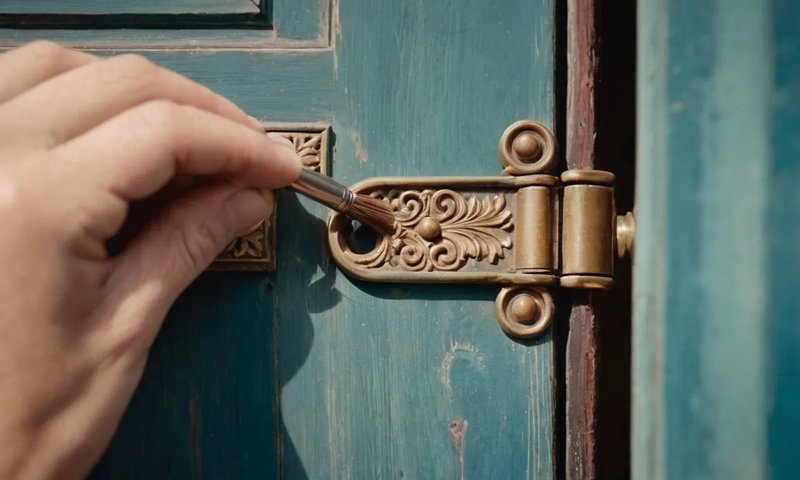
Here’s the truth: *Exterior* door hinges, like those on your front or back door, get hit with way more grime than their indoor cousins. Rain, dust, pollen, and even salty air (if you live near the coast) all team up to make things sticky and rough. And if you ignore them, you’ll eventually end up with binding—where the hinge grabs instead of glides, possibly damaging your door or frame. Whether you’re dealing with a sturdy Schlage or a no-name model, a little hinge maintenance can save you a lot of hassle (and noise).
Why Exterior Door Hinges Need Special Attention
Let me explain why *exterior* hinges don’t play by the same rules as the ones inside your house. For starters, they’re exposed to the wild world outside. Think about it: rainwater, mud splashes, blowing sand, and sticky pollen all end up right on the hinge pins and plates. Unlike inside, where dust is your main villain, outside you’ve got a whole lineup of grime getting into every moving part.
Here’s the thing—these contaminants can actually work their way *inside* the hinge joint. Over time, metal-on-metal friction increases, which leads to that annoying binding feeling. If left unchecked, you might even see rust start to creep in, especially on cheaper or untreated metals. Honestly, no door hinge, not even the big names like Schlage or Kwikset, is immune if you skip regular cleaning.
That’s why the best practices for cleaning exterior door hinges focus on *both* removing gunk and preventing new grime from settling in. Think of it as prepping a bike chain or giving your car’s moving parts a quick tune-up. A clean, lubricated hinge works smoother, stays quieter, and—most important—won’t bind up just when you’re in a hurry.
Signs Your Exterior Door Hinges Are Binding (And Why It Matters)
So how do you know if your exterior door hinges are crying for attention? Honestly, they’ll usually tell you. Binding is when the hinge starts to resist—the door feels “sticky,” hard to swing, or even sounds like it’s grinding. You might also see the door sag a little or notice black dust (that’s metal shavings or old lubricant) around the hinge.
Here are some classic symptoms:
- Squeaky or grinding noises when you open or close the door
- Difficulty moving the door—it feels heavy or sticks at certain points
- Visible rust or buildup on the hinge pin or plates
- Misaligned door (sometimes, binding causes the door to drag or not latch)
Why does this matter? Besides being annoying, binding can actually wear out both the hinge and the door frame. Left unchecked, the extra force can pull screws loose or even warp softer wood around the hinge. In some cases, you’ll end up with a door that won’t close at all—right when you need security the most.
Bottom line: If you notice any of these signs, it’s time to get proactive with a deep clean and some smart maintenance.
What You’ll Need: Tools and Materials for Cleaning Exterior Hinges
Before you start scrubbing, you’ll want to gather the right gear. No high-tech tools here, just simple stuff you probably already have:
- Flathead screwdriver (for popping out hinge pins and prying off stubborn grime)
- Clean rags or microfiber towels (you’ll want extras for wiping away old grease and grit)
- Brushes (an old toothbrush works well for getting into tiny grooves)
- Mild dish soap and warm water (for basic cleaning—no harsh chemicals needed)
- Lubricant—like silicone spray, white lithium grease, or a dash of WD-40 (no vegetable oil, please!)
- Masking tape (to help realign hinge pins or avoid scratching your door’s paint)
If your hinges are especially rusty, a little steel wool or fine sandpaper can help buff away surface corrosion. But be gentle—too much scrubbing can scratch up plated or painted finishes, especially if you’re dealing with name-brand hardware.
Step-By-Step: How to Clean Exterior Door Hinges
Ready to get your hinges running smooth again? Here’s a step-by-step system that covers every detail—even if you’ve never done this before. Take your time, and don’t rush; patience is your friend!
1. Open the Door Wide
Start by swinging the door open as far as it’ll go. You want clear access to the hinges. If the door is heavy, ask someone to hold it steady, especially if you’re working solo or worried about it shifting.
2. Remove the Hinge Pins
Slip a flathead screwdriver under the head of the hinge pin and gently tap upward with a hammer. If it’s stuck (they often are), a spritz of WD-40 at the joint can loosen things up. Slide pins out and set them aside. If the door tries to drop or sag, wedge something underneath—an old book or sturdy shoe works in a pinch.
3. Clean Off the Grime
Dip your rag in soapy water and scrub both the hinge leaves (the plates) and the pin itself. Use the old toothbrush to get into tight corners. For rust or thick gunk, gently rub with steel wool. Dry everything thoroughly to avoid water spots or hidden moisture.
4. Lubricate Before Reassembling
Here’s the secret: Don’t just spray and pray. Apply a small amount of *silicone spray* or white lithium grease along the hinge pin and inside the hinge barrel. This creates a slick, protective layer that resists moisture and dirt. Avoid vegetable or cooking oils—they’ll go sticky and attract more debris.
5. Reinstall the Pins And Test
Slide each pin back in (lining up the hinge plates carefully), then tap down until seated. Open and close the door a few times. If it still squeaks or feels sticky, repeat the process or add a touch more lubricant.
Cleaning and lubricating your door hinges once or twice a year is usually enough—unless your area is especially wet or dusty.
Choosing The Right Lubricant For Outdoor Hinges
Here’s where a lot of DIYers get tripped up. Not every lubricant works well outside. You might be tempted to grab whatever oil or spray is in the garage, but outdoor hinges need something tougher. Why? Because they have to fight off rain, temperature swings, and even salty air.
Let’s run through your best options:
- Silicone spray: It’s water-resistant, doesn’t attract dust, and lasts for months. A top pick for most climates.
- White lithium grease: Thicker than silicone, great for metal-on-metal contact, and stands up to rain. Just don’t overdo it—a little goes a long way.
- WD-40: Good for freeing stuck pins or breaking up old grease, but it’s not a long-term lubricant. Use it for cleaning, then follow with grease or silicone.
Stay far away from “home remedies” like vegetable oil or petroleum jelly. They actually gum up faster and can attract dirt, making binding worse.
How To Prevent Exterior Door Hinges From Binding In The Future
You might be wondering: Once my hinges are clean and smooth, how do I *keep* them that way? Honestly, the answer is all about prevention. Regular attention now saves you way more hassle later on.
Try this:
- Wipe down hinges any time you notice dirt, pollen, or cobwebs building up.
- Lubricate hinges twice a year—spring and fall are good reminders, since those are the seasons when weather changes the most.
- Check for rust after big rainstorms or if you live by the beach; salt and moisture are notorious for speeding up corrosion.
- Tighten loose screws so hinges stay aligned and don’t start binding in new (and annoying) ways.
If your area gets especially harsh weather, consider upgrading to stainless steel or brass hinges. They resist rust and binding much better than cheap painted steel.
When To Replace, Not Clean, Exterior Door Hinges
No amount of cleaning can save a hinge that’s truly worn out. If you see deep rust pits, big bends, or missing pieces, it’s time for a swap. Same goes for hinge pins that are badly scored or won’t slide in smoothly, even after oiling.
Here’s how to know:
- Deep rust that won’t scrub away, or crumbling metal around the screw holes
- Visible warping (the hinge leaf is no longer flat)
- Missing screws or screw holes that have gotten so wide, the screw just spins
Upgrading to a better hinge—like those from Schlage, Baldwin, or Emtek—is usually a one-time fix. Universal hinges work in most cases, but if your door is oddly sized or uses unique hardware, bring an old hinge to the hardware store so you get an exact match.
Common Troubleshooting: What If My Hinges Still Bind After Cleaning?
Done everything right and your door still sticks? Don’t worry, you’re not alone. Sometimes the problem isn’t just dirty hinges. Here’s where troubleshooting comes in handy.
- The door is out of alignment: If the screws holding your hinges are loose or the door has shifted, cleaning won’t solve the problem. Try tightening all hinge screws (top and bottom). If holes are stripped, fill with a wood dowel and re-screw.
- Hinge size mismatch: Sometimes, previous repairs mixed and matched hinge sizes or brands. If your hinge looks different from the others, swap it for a matching set.
- Frame swelling: Wood doors can swell in wet weather, causing binding even after hinge maintenance. In that case, trimming the door edge might be your best solution.
If you’re stumped, don’t hesitate to ask a local handyman for advice. Hinges are simple, but older homes or misaligned frames sometimes need a pro’s touch to get things just right.
Wrapping Up: Keep Door Hinges Gliding Smoothly With Simple Care
Honestly, cleaning exterior door hinges isn’t rocket science, but it’s one of those small jobs that makes a big difference. A clean, well-lubricated hinge isn’t just quieter—it keeps your doors safe from binding, sagging, or unexpected repairs. Whether you’re working with a classic Schlage hinge or a basic no-brand version, following these best practices will keep your entryways gliding for years to come.
A little attention twice a year, the right lubricant, and some quick troubleshooting when things feel sticky—that’s all it takes. If you make hinge maintenance part of your home care routine, your doors will always open with a smooth, satisfying swing, rain or shine.
